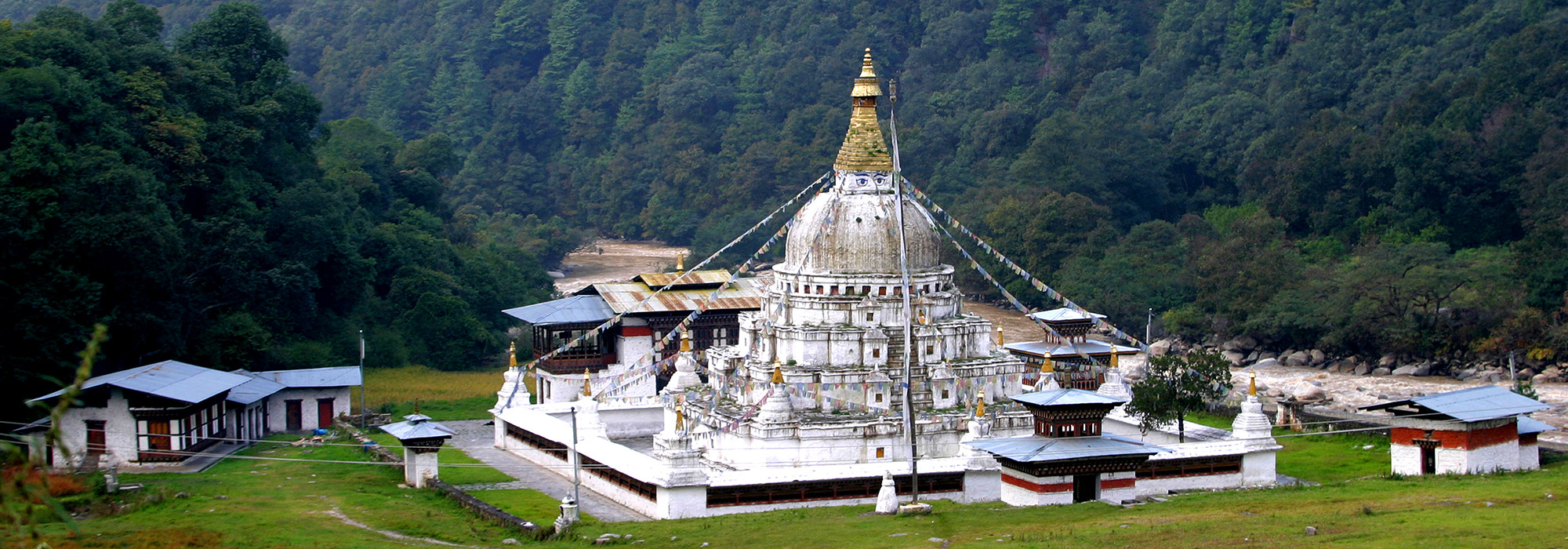Eastern Bhutan is one of the least explored regions of the kingdom and offers one of most authentic experiences for adventure-oriented tourists. The entire region is awash in unspoiled natural beauty, towering cliffs and pristine forests with great variations in altitude and climatic conditions.
In addition to the regular Buddhist festivals, travellers to Eastern Bhutan will be able to experience some of the country’s most ancient spiritual practices while observing Animistic and Bon religious rituals.
The lush, breathtaking environments of the eastern region make it a perfect location for day hikes or longer treks. Accommodations in this rural area are a bit more Spartan than other parts of country but with the option to either camp out beneath an ocean of stars or experience the unbridled warmth and hospitality of the locals during a homestay you’ll never miss the comforts of your hotel room.
The Eastern circuit includes the districts of Mongar, Lhuntse, Tashi Yangtse, Tashigang and Samdrup Jongkhar.
Trashigang
The Jewel of the East – Trashigang spans the easternmost corners of the kingdom, skirting up to the edge of the Indian state of Arunachal Pradesh. It is the country’s largest district, with an altitude ranging from 600m to over 4000m.
Bhutan’s largest river, the Dangmechu, flows through this district. Trashigang town is set on a scenic hillside and was once a bustling trade center for merchants looking to barter their goods in Tibet.
Today it is the junction of the East-West highway, with road connections to Samdrup Jongkhar and then into the Indian state of Assam. Trashigang town is also the principle market place for the semi-nomadic people of Merak and Sakteng, whose unique way of dress stands out from the regular Bhutanese Gho and Kira.
Trashiyangtse
One of the newest dzongkhags (district) in the country, Trashiyangtse was established as a distinct district in 1992 and spans 1,437 sq km of sub-tropical and alpine forests. With its wealth of natural, historical and cultural resources Trashiyangtse is destination that visitors to Bhutan will never forget.
Elevation 1750-1880m
A 2 hour drive from Trashigang is Chorten Kora, modeled after Boudhanath stupa in Nepal, where local people and Dakpa people from Arunachal Pradesh (India) gather in February/March for a festival to circumambulate the chorten. A similar festival in Gom Kora takes place 10 days later. Bumdeling to the north is home to wintering black-necked cranes and to Ludlow’s Bhutan Glory, the national butterfly of Bhutan. Important religious sites are found all over the Dzongkhag and include Pemaling in the alpine area; Rigsum Gonpa, Dechenphodrang ney and Omba ney (the Taktshang of East Bhutan) between 2000 and 3000m, and Gongza ney and Gom Kora along the Drangme Chu (800-900m).
Mongar
The road approaching Mongar is one of the most spectacular journeys in the country. It passes over sheer cliffs and through beautiful fir forests and green pastures. Travelers passing this way will have the opportunity to visit the Rhododendron garden. There are countless varieties of rhododendrons here and on clear days you can even catch a glimpse of Gangkhar Puensum (7541 meters), the world’s highest unclimbed mountain.
Mongar, one of the six districts that make up eastern Bhutan borders Bumthang, Lhuentse, Pema Gatshel and Trashigang. The district covers an area of 1,954 sq.kms with elevations ranging from 400m to 4,000m and has a population of about 38,000. The landscape is spectacular with stark cliffs and deep gorges set amidst dense conifer forests. The region is known for its weavers and textiles and fabrics produced here are considered some of the best in the country.
Lhuntse
In the north-eastern corner of Bhutan lies the ancient region of Kurtoe or Lhuntse as it is known today. It is the ancestral home of our Kings and hosts several of the sacred sites of pilgrimage in the country. It is located 77km from Mongar (3 hours’ drive) and is one of the most isolated districts in Bhutan.
The landscape is spectacular, with stark cliffs towering above river gorges and dense coniferous forests. The region is famous for its weavers, and their distinctive textiles are generally considered to be the best in the country. Kurtoep women are especially adept at weaving a textile called Kishuthara.
Samdrup Jongkhar
Samdrup Jongkhar town holds the distinct honor of being the oldest town in Bhutan. This border town is a bustling little settlement packed to the brim with shopkeepers and hawkers from across the border.
There are several well maintained hotels, most of which serve a good mix of Bhutanese, Indian and continental cuisine. As a border town, Samdrup Jongkhar is often used as the entry point for merchants and tourists entering Eastern Bhutan overland.
A little way outside the town you can find the Mithun Breeding Farm. Mithuns are widely considered to be the best breed of cattle in Bhutan and this farm supplies farmers from the six eastern districts with this magnificent animal.
Pemagatshel
The name Pemagatshel translates to “Lotus Garden of Happiness”. This 517.8 sq km district is located in South Eastern Bhutan and its altitude ranges from 1,000-3,500 meters. Over half of the small Dzongkhag is under the cover of broadleaf and coniferous forests and most of the remainder is farmland.
The main crop grown in the region is Maize (Corn) but Potatoes, Oranges, Bananas and other fruits are also cultivated. ‘Slash and Burn Agriculture’ (Tseri) was once the dominant agricultural practice in the district but nowadays most farmers have orchards and sell much of their crop.

